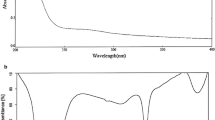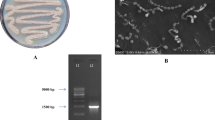Abstract
Marine bacteria are considered as imperative source for novel antibacterial compounds. The marine Streptomyces species was isolated from the sediment sample collected at the coast of Andaman and Nicobar Islands, India and identified as Streptomyces sp. VITAK1. The petroleum ether (PE) extract prepared from the culture supernatant of the isolate was purified by silica gel column chromatography using a mixture of PE and ethyl acetate (1 : 1 vol/vol) as solvent system. The purified compound was identified by using 1H and 13C NMR spectral data and GC-MS based on the similarity index with the reference compounds available in the mass spectra library of National Institute for Standards and Technology as coumarin-6-ol, 3,4-dihydro-4,4,5,7-tetramethyl- (CDTM). The antibacterial activity of the purified compound was tested according to the National Committee for Clinical Laboratory Standards guidelines and it was revealed that the lead compound showed IC50 value ranging from 2.5–40 µg/mL against tested bacterial pathogens. Proteus vulgaris was the most susceptible (IC50: 2.5 µg/mL) to inhibition by CDTM. In addition, the lead compound showed concentration-dependent anticoagulant activity with human blood samples. The results of the study suggest that Streptomyces sp. VITAK1 is the potential source for coumarin type of antibacterial compound.
Similar content being viewed by others
References
Hakvag, S., Fjaervik, E., Josefsen, K.D., Ian, E., Ellingsen, T.E., and Zotchev, S.B., Marine Drugs, 2008, vol. 6, no. 3, pp. 620–635.
Suthindhiran, K. and Kannabiran, K., J. Med. Mycol., 2009, vol.19, no.2, pp. 77–86.
Meena, B., L. Rajan, A., Vinithkumar, N.V., and Kirubagaran, R., BMC Microbiol., 2013, vol. 13, no. 2, pp. 145–162.
Zaki, R.M., Elossaily, Y.A., and Kamal, A.M., Russ. J. Bioorg. Chem., 2012, vol. 38, no. 6, pp. 639–646.
Asha Devi, N.K., Rajendran, R., and Karthik Sundaram, S., Ind. J. Nat. Prod. Resour., 2011, vol. 2, no. 1, pp. 59–64.
Sujatha, P., Bapiraju, K.V., and Ramana, T., World J. Microbiol. Biotechnol., 2005, vol. 21, no. 4, pp. 583–585.
Baskaran, R., Vijayakumar, R., and Mohan, P.M., Malaysian J. Microbiol., 2011, vol. 7, no. 1, pp. 26–32.
Poosarla, A., Ramana, V.L., and Krishna, M.R., J. Microbiol. Antimicrob., 2011, vol. 5, no.1, pp. 6–12.
Vinay Gopal, J., Subashini, E., and Kannabiran, K., J. Korean Soc. Appl. Biol. Chem., 2013, vol. 56, no. 4, pp. 361–367.
Naikpatil, S.V. and Rathod, J.L., J. Ecobiotechnol., 2011, vol. 3, no. 10, pp. 48–53.
Mahajan, R., and Dhananjay, M., Int. J. Pharm. Sci., 2012, vol. 4, no. 4, pp. 498–500.
Shirling, E.B. and Gottlieb, D., Int. J. Sys. Bacteriol., 1966, vol. 16, no. 3, pp. 313–340.
Bruneton, J., Saudi Pharmaceutical J., 1999, vol. 11, no. 3. pp. 263–277.
Egan, D., Kennedy, R., Moran, E., Cox, D., Prosser, E., and Thornes, R.D., Drug Metab. Rev., 1990, vol. 22, no. 5, pp.503–529.
Lake, B., Food Chem. Tox., 1999, vol. 37, no. 4, pp. 423–453.
Cooke, D., Fitzpatrick, B., Kennedy, R., McCormack, T., and Egan, D., in Coumarins: Biology, Applications and Mode of Action, O’Kennedy, R. and Thornes, R.D., Eds., Chichester: John Wiley and Sons, 1997, pp. 303–332.
Lacy, A. and Kennedy, R., Curr. Pharm. Des., 2004, vol. 10, no. 30, pp. 3797–3811.
Taechowisan, T., Lu, C., Shen, Y., and Lumyong, S., Microbiology, 2005, vol. 51, no. 4, pp. 1691–1695.
Saurav, K. and Kannabiran, K., Der. Pharmacia Lettre, 2013, vol. 5, no. 3, pp.178–184.
Souzaa, S.M., Monacheb, F.D., and Artur Smania, J.R., Z. Naturforsch., 2005, vol. 60, pp. 693–700.
Smyth, T., Ramachandran, V.N., and Smyth, W.F., Int. J. Antimicrob. Agents, 2009, vol. 33, no. 9–10, pp. 421–426.
Venugopala, K. N., Rashmi, V., and Odhav, B., BioMed. Res. Intl., 2013, Article ID 963248.
Author information
Authors and Affiliations
Corresponding author
Additional information
The article is published in the original.
Rights and permissions
About this article
Cite this article
Abirami, M., Gopal, J.V. & Kannabiran, K. Extraction and identification of antibacterial compound from marine Streptomyces sp. VITAK1 isolated from the coast of Andaman and Nicobar Islands, India. Appl Biochem Microbiol 51, 406–410 (2015). https://doi.org/10.1134/S000368381504002X
Received:
Published:
Issue Date:
DOI: https://doi.org/10.1134/S000368381504002X




